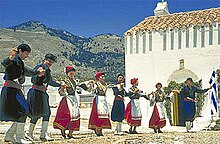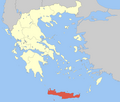Sfakia
Sfakia
Σφακιά | |
|---|---|
 Sfakia landscape around Hóra Sfakíon | |
| Coordinates:35°12′N24°08′E/ 35.200°N 24.133°E | |
| Country | Greece |
| Administrative region | Crete |
| Regional unit | Chania |
| Government | |
| • Mayor | Ioannis Zervos[1](since 2023) |
| Area | |
| • Municipality | 467.6 km2(180.5 sq mi) |
| Population (2021)[2] | |
| • Municipality | 2,002 |
| • Density | 4.3/km2(11/sq mi) |
| Time zone | UTC+2(EET) |
| • Summer (DST) | UTC+3(EEST) |
| Area code(s) | 73011 |
| Vehicle registration | ΧΝ |


Sfakiá(Greek:Σφακιά) is a mountainous area in the southwestern part of the island ofCrete,in theChaniaregional unit. It is considered to be one of the few places inGreecethat have never been fully occupied by foreign powers. With a 2021 census population of 2,002 inhabitants living on a land area of 467.589 km2(180.537 sq mi),[3]Sfakia is one of the largest andleast densely populatedmunicipalitieson the island of Crete. Theetymologyof its name is disputed. According to the prevailing theory, it relates to its rugged terrain, deriving from the ancient Greek wordσφαξ,meaning land chasm or gorge.[4]
Description
[edit]The road fromChaniato Sfakiá crosses the island from north to south, through the village ofVryses.From this village the route crosses the White Mountains (Lefká Óri) toHóra Sfakíon(35°12′N24°08′E/ 35.200°N 24.133°E) by theLibyan Sea.Halfway from Vrisses to Hóra Sfakíon is the fertile plateau ofAskifou,surrounded by high mountain peaks. From here to Hóra Sfakíon the road is particularly spectacular. The road hugs the western slope of theImbros Gorgeoffering scenic views. Another scenic route is that leading fromKapsodasosto the plateau ofKallikratis,northeast of Hóra Sfakíon.
There are many beaches in Sfakiá which do not see the numbers of tourists of the northern coast. More adventurous visitors can follow the European hiking footpathE4which crosses Crete through Sfakiá's mountains. The coastal villages are not connected by a coastal road, but can be reached by ferry boats.
Not far east from Hóra Sfakíon isFrangokastello,literally "Frankishcastle ". TheVenetianfortress here was built in 1371 to deter pirates and unsuccessfully, to control Sfakiá. It is largely ruined but is picturesquely set on a wide sandy beach with the towering White Mountains behind.Daskalogianniswas captured here in 1771.
Accessible only by boat from Sfakiá isLoutro,a small seaside village with some archaeological ruins, a few houses, small hotels and tavernas. Loutro is car-free; cars must be parked in Hóra Sfakíon or Paleohóra. In the north of Sfakiá is the fertile plain of Askyfou. The Sfakía region is crossed by many gorges, among which is the famousSamaria Gorge.All these gorges run from north to south and all end in the sea. Many of them can be walked, several even by inexperienced walkers. The region is inhabited by rare animals, like vultures and eagles, and thekri-kri(oragrimi), the wild Cretan goat. The coast of Sfakiá is on the Libyan Sea, which is inhabited by a diminishing fish population, but occasionally dolphins, and even whales may be seen. The idea of inaccessibility and ruggedness has played a key role in how Sfakia has been represented since at least the 18th century and it is reiterated in various ways today by tourists and locals.[5]
The local speciality, "Sfakian Pies", are thin pancakes filled withmizithracheese and served drizzled with honey.
Resistance
[edit]Hóra Sfakíon is famous as one of the centers of the resistance against the occupying forces of both theVenetiansand theTurks.The impenetrable White Mountains to the north combined with the rocky beaches on the south helped the locals fight off all invaders. Anopolis, a village near Hóra Sfakíon, is the birthplace of one of the most celebrated Cretan revolutionaries,Daskalogiannis.
A famous legend and unexplained phenomenon describes a procession of visions (Drosoulites) seen in the nearby village Frangokastello as troops that died in the war of independence against the Turks.
Patrick Leigh Fermorwrote about the tall proud Sfakians and their resistance to occupation. Many tales of revolts and uprisings in Crete start in the mountains of western Crete - mountain guerillas,pallikarifighters and rebel assemblies.
After theBattle of CreteduringWorld War II,the locals helped manyAustralianandNew Zealandsoldiers escape from here on the night of May 31, 1941, suffering great reprisals. KingGeorge II of Greecehad already escaped this way when theGermansinvaded. Near the village of Komitades is the Church of Panagia Thymiani where the revolution of 1821 began. At the village of Loutro is the ruined "chancellery" where the first revolutionary government of 1821 met.
Sfakiá is notorious for the harshness of the environment and the warlike people. Sfakians themselves are still considered somewhat beyond the reach of the lawmakers and tax collectors ofAthens,withvendettasover stolen sheep and women's honour still fought into the mid-20th century, with a whole village abandoned.
Stealing and banditry had been considered a way of life in the mountains, even appearing in aCreation myth,which made God Himself a Sfakiot, as recounted by Adam Hopkins:
- ...with an account of all the gifts God had given to other parts of Crete - olives to Ierapetra, Ayios Vasilios and Selinou; wine to Malevisi and Kissamou; cherries to Mylapotamos and Amari. But when God got to Sfakia only rocks were left. So the Sfakiots appeared before Him armed to the teeth. "And us Lord, how are we going to live on these rocks?" and the Almighty, looking at them with sympathy, replied in their own dialect (naturally): "Haven't you got a scrap of brains in your head? Don't you see that the lowlanders are cultivating all these riches for you?"
The Sfakians are also famous for their hospitality and generosity towards guests, resulting in a shift from traditional labour towards tourism, with now many families running their own small hotel or restaurant. Many northern European visitors to the area in the 1970s onward who still return today stress hospitality as key element that attracted them to Sfakia. Conversing with these visitors' impressions, locals are very interested in the idea of hospitality as a form of cultural distinctiveness and morality and they often debate what it means to speak of hospitality in the age of mass tourism.[6]
History
[edit]The archeology and history of Sfakia is the object of afield surveyundertaken by theUniversity of Oxford.[7][8]
Province
[edit]The province of Sfakia (Greek:Επαρχία Σφακίων) was one of theprovincesof the Chania Prefecture. It had the same territory as the present municipality.[9]It was abolished in 2006.
See also
[edit]References
[edit]- ^"Municipality of Sfakia, Municipal elections – October 2023".Ministry of Interior.
- ^"Αποτελέσματα Απογραφής Πληθυσμού - Κατοικιών 2021, Μόνιμος Πληθυσμός κατά οικισμό"[Results of the 2021 Population - Housing Census, Permanent population by settlement] (in Greek). Hellenic Statistical Authority. 29 March 2024.
- ^"Population & housing census 2001 (incl. area and average elevation)"(PDF)(in Greek). National Statistical Service of Greece.
- ^The derivation of the name of Sfakia
- ^Kalantzis, Konstantinos (2019).Tradition in the Frame: Photography, Power and Imagination in Sfakia, Crete.Indiana University Press.ISBN978-0-253-03712-1.
- ^Kalantzis, Konstantinos (2019).Tradition in the Frame: Photography, Power and Imagination in Sfakia, Crete.Indiana University Press.ISBN978-0-253-03712-1.
- ^The Archaeology of Crete,Simon R. F. Price,L. Nixon, 2002[1]
- ^The Sphakia Survey: Internet Edition,Simon R. F. Price, L. Nixon, J. Moody and O. Rackham, 2000[2]
- ^"Detailed census results 1991"(PDF).(39 MB)(in Greek and French)
External links
[edit]- Portal site about the region of Sfakiá
- Jane Francis; Simon Price; Jennifer Moody; Lucia Nixon (November 2000)."Agiasmatsi: a Greek cave sanctuary in Sphakia, SW Crete".Annual of the British School at Athens.95:427–471.doi:10.1017/S0068245400004755.



